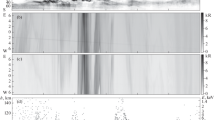Abstract
The possibility of comparing in detail CLUSTER satellite data with data on pulsating spots registered with a TV camera at the Lovozero Observatory when the satellite crossed the magnetospheric region related to the camera’s field of view is discussed. The satellite ionospheric projections were calculated using the T89, T96, and T01 models. It was shown that the projection allows us to judge with confidence whether or not a satellite will find itself in a region of pulsating auroras when only the level of geomagnetic activity and the characteristics of the interplanetary medium are a priori known. When different models are used in the projection, the spread is not less than the characteristic dimensions of the pulsating spots and can be as high as 100 km. The corresponding satellite flight time is ∼4 min. Such a large spatial and time uncertainty does not allow us to compare in detail the satellite data with ground-based optical measurements without a priori information on, e.g., the character of precipitation above a spot, as has been done by other researchers in the case of auroral arcs. The situation becomes even more complex if a satellite is in the region of greatly stretched magnetic field lines.
Similar content being viewed by others
References
Aikio, A., Mursula, K., Buchert, S., et al., Temporal Evolution of Two Auroral Arcs as Measured by the Cluster Satellite and Coordinated Ground-Based Instruments, Ann. Geophys., 2004, vol. 22, no. 12, pp. 4089–4101.
Amm, O., Aikio, A., Bosqued, J.-M., et al., Mesoscale Structure of a Morning Sector Ionospheric Shear Flow Region Determined by Conjugate Cluster II and MIRACLE Ground-Based Observations, Ann. Geophys., 2003, vol. 21, no. 8, pp. 1737–1751.
Blockx, C., Gérard, J.-C., Coumans, V., et al., A Comparison between FUV Remote Sensing of Magnetotail Stretching and the T01 Model during Quiet Conditions and Growth Phases, Ann. Geophys., 2007, vol. 25, no. 1, pp. 161–170.
Cash, S.R., Davies, J.A., Kolesnikova, E., et al., Electron Acceleration Observed by the FAST Satellite within the IAR during a 3 Hz Modulated EISCAT Heater Experiment, Ann. Geophys., 2002, vol. 20,no. 9, pp. 1499–1507.
Figueiredo, S., Marklund, G.T., Karlsson, T., et al., Temporal and Spatial Evolution of Discrete Auroral Arcs as Seen by Cluster, Ann. Geophys., 2005, vol. 23, no. 7, pp. 2531–2557.
Newell, P.T. and Meng, C.-I., Mapping the Dayside Ionosphere to the Magnetosphere according to Particle Precipitation Characteristics, Geophys. Res. Lett., 1992, vol. 19, no. 6, pp. 609–612.
Ober, D.M., Maynard, N.C., Burke, W.J., et al., Mapping Prenoon Auroral Structures to the Magnetosphere, J. Geophys. Res., 2000, vol. 105, no. 12, pp. 27519–27530.
Pitout, F., Escoubet, C., and Lucek, E., Ionospheric Plasma Density Structures Associated with Magnetopause Motion: A Case Study Using the Cluster Spacecraft and the EISCAT Svalbard Radar, Ann. Geophys., 2004, vol. 22, no. 7, pp. 2369–2379.
Platino, M., Inan, U., Bell, T., et al., Cluster Observations of ELF/VLF Signals Generated by Modulated Heating of the Lower Ionosphere with the HAARP HF Transmitter, Ann. Geophys., 2004, vol. 22, no. 7, pp. 2643–2653.
Pulkkinen, T.I, Pellinen, R.J, Koskinen, H.E.J., et al., Auroral Signatures of Substorm Recovery Phase: A Case Study, Geophys. Monogr. Am. Geophys. Union, 1991, vol. 64, pp. 333–342.
Safargaleev, V., Kozlovsky, A., Sergienko, T., et al., Optical, Radar, and Magnetic Observations of Magnetosheath Plasma Capture during a Positive IMF Bz Impulse, Ann. Geophys., 2008, vol. 26, no. 3, pp. 517–531.
Sandholt, P.E., Ffrrugia, C.J., Cowley, S.W.H., et al., Dynamic Cusp Aurora and Associated Pulsed Reverse Convection during Northward Interplanetary Magnetic Field, J. Geophys. Res., 2000, vol. 105, no. 6, pp. 12 869–12 894.
Sato, N., Wright, D.M., Carslon, C.W., et al., Generation Region of Pulsating Aurora Obtained Simultaneously by the FAST Satellite and a Syowa-Iceland Conjugate Pair of Observatories, J. Geophys. Res., 2004, vol. 109, p. JA010419.
Tagirov, V., Auroral Torches: Results of Optical Observations, J. Atmos. Terr. Phys., 1993, vol. 55, no. 14, pp. 1775–1787.
Tsyganenko, N.A., A Model of the Near Magnetosphere with a Dawn-Dusk Asymmetry: 2. Parameterization and Fitting to Observations, J. Geophys. Res., 2002, vol. 107, p. JA000220.
Woodfield, E.E., Dunlop, M.W., Holme, R., et al., A Comparison of Cluster Magnetic Data with the Tsyganenko 2001 Model, J. Geophys. Res., 2007, vol. 112, p. JA012217.
Author information
Authors and Affiliations
Additional information
Original Russian Text © V.V. Safargaleev, D.N. Shibaeva, T.I. Sergienko, I.A. Kornilov, 2009, published in Solnechno-Zemnaya Fizika, 2009, Vol. 14, pp. 27–33.
Rights and permissions
About this article
Cite this article
Safargaleev, V.V., Shibaeva, D.N., Sergienko, T.I. et al. On the possibility of coupling satellite and ground-based optical measurements in the region of pulsating auroras. Geomagn. Aeron. 50, 873–879 (2010). https://doi.org/10.1134/S001679321007008X
Published:
Issue Date:
DOI: https://doi.org/10.1134/S001679321007008X




